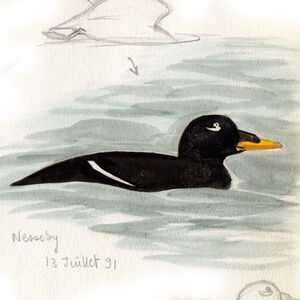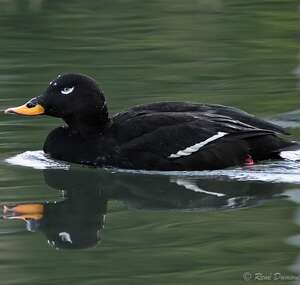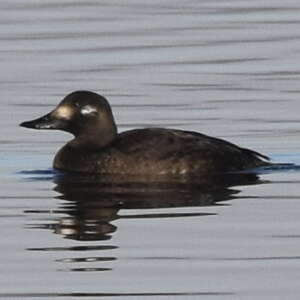Velvet Scoter
Melanitta fusca - Macreuse brune
Identification
The Velvet Scoter of Eurasia is a large diving duck of the western Eurasian continent. The old taxon Velvet Scoter has recently been split into 3 new species, the Velvet Scoter of Eurasia (or more simply Velvet Scoter) which we are concerned with here, the Siberian Scoter which inhabits the east of the continent, and the White-winged Scoter which inhabits the north of the North American continent. The Velvet Scoter (of Eurasia) has thus become monotypic.
Mating adults present a strong sexual dimorphism. The male on the water appears entirely black with a particular head and a white line in the wing. In fact, it is the beak which is particular with the area around the nostrils swollen and black. It itself is yellow to yellow-orange, bordered with black and with an orange-red tab. The iris is very pale gray and a clearly distinct oblique white comma emphasizes the eye. As for the white wing line, it is the part visible in the folded wing of the large white mirror formed by the secondary remiges and the tips of the large white coverts. Often it is hidden when the bird is at rest due to the flank feathers. On the other hand, when the bird is active, it has the habit of spreading its wings when diving, revealing the white. In flight, the large size, the entirely black feathering and the large white mirror at the back of the wing are diagnostic. The legs are pink-red to blackish palmetta. This phenotype does not appear on the mainland of France where it is birds of female type which are displayed on the large bodies of water.
The female adult has an entirely dark brown plumage. She also has the white wing mirror. On the other hand, its head is different. It shows a pale, beige area between the eye and the beak and a whitish patch behind the eye on the top of the ear coverts. The eye is dark. The beak is gray-blackish without basal swelling.From afar, it appears as a large, dark duck with a triangular-shaped head carrying two pale spots. The juvenile is similar to the female, but paler due to pale edgings on the feathers and with larger and more distinct pale spots on the head. During the first winter, it will be possible to sex the young birds. We will then see black appearing in the plumage of Velvet Scoter males.
Subspecific information monotypic species
Foreign names
- Macreuse brune,
- Negrón especulado,
- negrola-d'asa-branca,
- Samtente,
- füstös réce,
- Grote Zee-eend,
- Orco marino,
- svärta,
- Sjøorre,
- turpan tmavý,
- turpan hnědý,
- Fløjlsand,
- pilkkasiipi,
- ànec fosc,
- Korpönd,
- uhla (zwyczajna),
- tumšā pīle,
- beloliska,
- Турпан,
- ヨーロッパビロードキンクロ,
- 丝绒海番鸭,
- 斑臉海番鴨,
Voice song and call
Habitat
The Velvet Scoter breeds around small freshwater bodies in boreal forest and arctic tundra, a little along the wooded shores of the southern Baltic Sea, and east of its range, beyond the Ural, also along continental waters further inland.
It primarily winters out on the sea, usually in shallower waters of the coast, and in smaller numbers on continental waters, either on large rich benthic faunal waters or on favourably portions of large rivers such as the Danube. The young birds will stay at sea at the end of winter and will spend their entire second year there.
Behaviour character trait
Almost all of the Anatidae become gregarious after reproduction, and Velvet Scoters are no exception.
They gather in quiet moulting areas off the northern coast of Russia before embarking on their migration, which will take some as far as our own coasts.It is interesting to see the groups collectively searching for food. When diving, the birds spread their wings partially just before disappearing. Velvet Scoters indeed swim underwater with their legs, but also their wings, which makes them excellent divers and able to stay underwater for extended periods of time. They can also associate with other divers, such as Common Eiders and Great Crested Grebes, to mutual benefit.
Dietfeeding habits
The Velvet Scoter is an accomplished diver. It can dive down to a depth of 20 m using its webbed feet and wings as fins.
Its diet consists mostly of aquatic, marine and freshwater invertebrates. During the breeding season, it mainly consumes crustaceans, amphipods and others, as well as larval insects, particularly of certain diptera. A bit of plant material is also consumed.In the winter season at sea, the diet becomes remarkably malacophagous. It actively searches for a certain size of bivalves, especially blue mussels and other molluscs extracted from the substrate, but other invertebrates are also hunted, echinoderms (sea urchins), annelids (polychaete worms), crustaceans and some fishes.
Reproduction nesting
The breeding season extends from May to July. The species is monogamous. Pairs are territorial but tolerate neighbours in favourable sites.
They nest on the ground, within 100m of open water. The nest is made up of a few elements of its surrounding vegetation and lined with down before the eggs are laid. It is hidden by vegetation or by stones. The female lays 7-9 eggs (5-12) which she incubates alone for 26-29 days. Ducklings are nidifugous. Young from different families gather in crèches, but few survive the first few weeks. The female's fertility is in fact an adaptation to a high mortality rate of chicks at the start of their lives.Geographic range
The Velvet Scoter breeds in the north of the Eurasian continent on freshwater inland from the North Atlantic and Arctic Ocean coasts up to the Taymyr peninsula. The nesting range also extends beyond the Urals, reaching as far south as northern Kazakhstan. A small isolated population survives in the Caucasus region and in eastern Turkey on volcanic high altitude lakes.
In Autumn, the Velvet Scoter predominantly takes to the sea and arrives on the shores of the Atlantic, Black Sea and Caspian Sea, rarely making it as far north as the Mediterranean including the Gulf of Lions in France. Interior inland waters can also attract a few wintering birds, such as those in the Danube basin.
Threats - protection
Sources of information
- IOC World Bird List (v15.1), Gill, F and D Donsker (Eds). 2025-12-07.
- Canards, cygnes et oies d'Europe, d'Asie et d'Amérique du Nord, Reeber Sébastien
- Ducks, Geese and Swans, Kear, J
- Guide des canards, des oies et des cygnes, Steve Madge
- Les palmipèdes d'Europe, Géroudet P., MAJ M. Cuisin
- Wildfowl: An identification guide to the ducks geese and swans of the world, Madge, S and Burn, H
- xeno-canto, Sharing bird sounds from around the world,
- Avibase, Lepage Denis
- Birds of the World, The Cornell Lab of Ornithology
Other sources of interest
 Specification sheet created on
27/07/2023 by Jean François
Specification sheet created on
27/07/2023 by Jean FrançoisTranslation by AI Oiseaux.net
© 1996-2025 Oiseaux.net
- Accipitriformes
- Aegotheliformes
- Anseriformes
- Apodiformes
- Apterygiformes
- Bucerotiformes
- Caprimulgiformes
- Cariamiformes
- Casuariiformes
- Charadriiformes
- Ciconiiformes
- Coliiformes
- Columbiformes
- Coraciiformes
- Cuculiformes
- Eurypygiformes
- Falconiformes
- Galliformes
- Gaviiformes
- Gruiformes
- Leptosomiformes
- Mesitornithiformes
- Musophagiformes
- Nyctibiiformes
- Opisthocomiformes
- Otidiformes
- Passeriformes
- Pelecaniformes
- Phaethontiformes
- Phoenicopteriformes
- Piciformes
- Podargiformes
- Podicipediformes
- Procellariiformes
- Psittaciformes
- Pterocliformes
- Rheiformes
- Sphenisciformes
- Steatornithiformes
- Strigiformes
- Struthioniformes
- Suliformes
- Tinamiformes
- Trogoniformes































